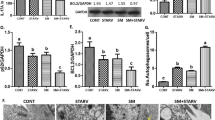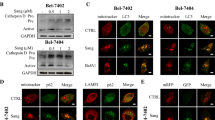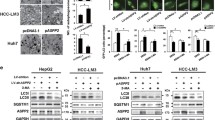Abstract
Transarterial chemoembolization (TACE) is the standard of care for treatment of intermediate hepatocellular carcinoma (HCC), however, key molecules involved in HCC cell survival and tumor metastasis post-TACE remain unclear. CD147 is a member of the immunoglobulin superfamily that is overexpressed on the surface of HCC cells and is associated with malignant potential and poor prognosis in HCC patients. In this study, using an Earle’s Balanced Salt Solution medium culture model that mimics nutrient deprivation induced by TACE, we investigated the regulation of CD147 expression on HCC cells under starvation conditions and its functional effects on HCC cell death. During early stages of starvation, the expression of CD147 was considerably upregulated in SMMC7721, HepG2 and HCC9204 hepatoma cell lines at the protein levels. Downregulation of CD147 by specific small interfering RNA (siRNA) significantly promoted starvation-induced cell death. In addition, CD147 siRNA-transfected SMMC7721 cells demonstrated significantly increased levels of both apoptosis and autophagy as compared to cells transfected with control siRNA under starvation conditions, whereas no difference was observed between the two treatment groups under normal culture conditions. Furthermore, silencing of CD147 resulted in a remarkable downregulation of phosphorylated mammalian target of rapamycin (p-mTOR) in starved SMMC7721 cells. Finally, the combined treatment of starvation and anti-CD147 monoclonal antibody exhibited a synergistic HCC cell killing effect. Our study suggests that upregulation of CD147 under starvation may reduce hepatoma cell death by modulating both apoptosis and autophagy through mTOR signaling, and that CD147 may be a novel potential molecular target to improve the efficacy of TACE.





Similar content being viewed by others
References
Biolato M et al (2010) Transarterial chemoembolization (TACE) for unresectable HCC: a new life begins? Eur Rev Med Pharmacol Sci 14(4):356–362
Shao W et al (2014) Transarterial chemoembolization combined with sorafenib for advanced hepatocellular carcinoma. Oncol Lett 8(5):2263–2266
Toole BP (2003) Emmprin (CD147), a cell surface regulator of matrix metalloproteinase production and function. Curr Top Dev Biol 54:371–389
Tang X et al (2012) CD147/EMMPRIN: an effective therapeutic target for hepatocellular carcinoma. J Drug Target. doi:10.3109/1061186X.2012.702769
Gou X et al (2009) HAb18G/CD147 inhibits starvation-induced autophagy in human hepatoma cell SMMC7721 with an involvement of Beclin 1 down-regulation. Cancer Sci 100(5):837–843
Ke X et al (2012) Hypoxia upregulates CD147 through a combined effect of HIF-1alpha and Sp1 to promote glycolysis and tumor progression in epithelial solid tumors. Carcinogenesis 33(8):1598–1607
Xu T, Chen X, Li D (2007) Expression of EMMPRIN in rabbit VX2 tumor tissue and significance. Chin J Exp Surg 24(1):37–38
Chen Y et al (2009) Upregulation of HAb18G/CD147 in activated human umbilical vein endothelial cells enhances the angiogenesis. Cancer Lett 278(1):113–121
Hou Q et al (2011) Berberine induces cell death in human hepatoma cells in vitro by downregulating CD147. Cancer Sci 102(7):1287–1292
Hecht M et al (2015) Efavirenz has the highest anti-proliferative effect of non-nucleoside reverse transcriptase inhibitors against pancreatic cancer cells. PLoS One 10(6):e0130277
Drake KR, Kang M, Kenworthy AK (2010) Nucleocytoplasmic distribution and dynamics of the autophagosome marker EGFP-LC3. PLoS One 5(3):e9806
Deng B et al (2013) Targeted delivery of neurogenin-2 protein in the treatment for cerebral ischemia-reperfusion injury. Biomaterials 34(34):8786–8797
Yu L et al (2004) Regulation of an ATG7-beclin 1 program of autophagic cell death by caspase-8. Science 304(5676):1500–1502
Drachman JG et al (2002) Studies with chimeric Mpl/JAK2 receptors indicate that both JAK2 and the membrane-proximal domain of Mpl are required for cellular proliferation. J Biol Chem 277(26):23544–23553
Xu J et al (2007) HAb18G/CD147 functions in invasion and metastasis of hepatocellular carcinoma. Mol Cancer Res 5(6):605–614
Martin R et al (2012) Safety and efficacy of trans arterial chemoembolization with drug-eluting beads in hepatocellular cancer: a systematic review. Hepatogastroenterology 59(113):255–260
Sacco R et al (2011) Conventional versus doxorubicin-eluting bead transarterial chemoembolization for hepatocellular carcinoma. J Vasc Interv Radiol 22(11):1545–1552
Bai W et al (2013) Sorafenib in combination with transarterial chemoembolization improves the survival of patients with unresectable hepatocellular carcinoma: a propensity score matching study. J Dig Dis 14(4):181–190
Park JW et al (2012) Phase II study of concurrent transarterial chemoembolization and sorafenib in patients with unresectable hepatocellular carcinoma. J Hepatol 56(6):1336–1342
Qu XD et al (2012) The efficacy of TACE combined sorafenib in advanced stages hepatocellullar carcinoma. BMC Cancer 12:263
Liou TC et al (1995) Pulmonary metastasis of hepatocellular carcinoma associated with transarterial chemoembolization. J Hepatol 23(5):563–568
Song BC et al (2001) Association between insulin-like growth factor-2 and metastases after transcatheter arterial chemoembolization in patients with hepatocellular carcinoma: a prospective study. Cancer 91(12):2386–2393
Sergio A et al (2008) Transcatheter arterial chemoembolization (TACE) in hepatocellular carcinoma (HCC): the role of angiogenesis and invasiveness. Am J Gastroenterol 103(4):914–921
Liu L et al (2010) Influence of hepatic artery occlusion on tumor growth and metastatic potential in a human orthotopic hepatoma nude mouse model: relevance of epithelial-mesenchymal transition. Cancer Sci 101(1):120–128
Kou X et al (2013) Tumor necrosis factor-alpha attenuates starvation-induced apoptosis through upregulation of ferritin heavy chain in hepatocellular carcinoma cells. BMC Cancer 13:438
Lin Y et al (2014) Elemene injection induced autophagy protects human hepatoma cancer cells from starvation and undergoing apoptosis. Evid Based Complement Alternat Med 2014:637528
Yang CH, Cho M (2013) Hepatitis B virus X gene differentially modulates cell cycle progression and apoptotic protein expression in hepatocyte versus hepatoma cell lines. J Viral Hepat 20(1):50–58
Zhou L et al (2010) The mTOR pathway is associated with the poor prognosis of human hepatocellular carcinoma. Med Oncol 27(2):255–261
Zhou Q, Lui VW, Yeo W (2011) Targeting the PI3K/Akt/mTOR pathway in hepatocellular carcinoma. Future Oncol 7(10):1149–1167
Kudo M (2011) mTOR inhibitor for the treatment of hepatocellular carcinoma. Dig Dis 29(3):310–315
Acknowledgments
This work was supported by Grant Nos. 81101744, 81402063, 81271290 from the National Natural Science Foundation of China, Grant No. 2011JM4038 from the Natural Science Basic Research Plan in Shaanxi Province of China, 12JK0699 Scientific Research Program Funded by Shaanxi Provincial Education Department and Grant 14ZRZD01 from Scientific Research Project of Sichuan College of Traditional Chinese Medicine.
Author information
Authors and Affiliations
Corresponding authors
Ethics declarations
Conflict of interests
The authors have no conflicts of interest to declare.
Authors’ contributions
XG and YC designed and performed the experiments, analyzed the data, and wrote the paper; XT designed the experiments, analyzed the data, and wrote the paper; DK analyzed the data and wrote the paper; HX, NG, ZH and ZZ designed the experiments, analyzed the data. All authors read and approved the final manuscript.
Additional information
Xingchun Gou and Xu Tang have contributed equally to this work.
Rights and permissions
About this article
Cite this article
Gou, X., Tang, X., Kong, D.K. et al. CD147 is increased in HCC cells under starvation and reduces cell death through upregulating p-mTOR in vitro. Apoptosis 21, 110–119 (2016). https://doi.org/10.1007/s10495-015-1189-y
Published:
Issue Date:
DOI: https://doi.org/10.1007/s10495-015-1189-y




